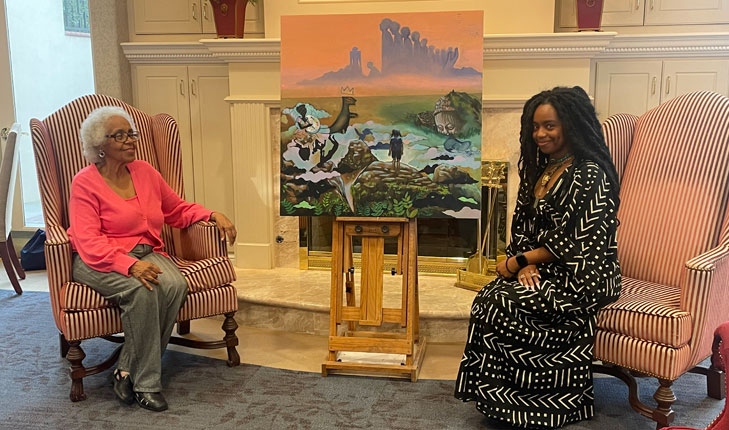Artists are known as mirrors to society. But for artist Audia Dixon, art is more than a mirror — it is an opportunity to reflect all that can be beyond what already exists.
In Dixon’s latest work, “Where the Black Voices Dwell,” a painting commissioned by the Africana Studies Program at Fresno State, Dixon sought to bring homage to Black artists beyond “the white walls” of museums.
“I thought about instead of painting portraits of famous Black artists throughout history, it’s good to put a face on it, so, I thought, ‘what if I just make a whole landscape that looks like art made by Black people?” Dixon said.
Mixing surrealist and landscape art, Dixon’s “Where the Black Voices Dwell” shows the art of famous Black artists in a landscape setting.
The viewer sees the painting through the eyes of a little Black girl, Dixon said. To her left she can spot Jean-Michael Basquiat’s dinosaur from the 1984 painting Pez Dispenser. Straight ahead the girl can see the clouds form into the 1939 sculpture “Lift Every Voice and Sing (the Harp)” by Harlem Renaissance sculptor Augusta Savage.
The more the viewer looks at the painting, the more the viewer will spot easter eggs paying tribute to artists Kara Walker, Kerry James Marshall, Elizabeth Catlett and Aaron Douglas.
“I wanted to make it feel like this person’s walking to the world of Black creativity,” Dixon said. “Kind of like Narnia, you walk into Narnia, you see all this magic, right? I want to see a young Black person walk into a world of creative art lives and where it all dwells.”
For Dixon, her creation speaks to the importance of Black representation in art. Dixon said she never saw many Black artists growing up.
In fact, Dixon, who won the President’s Graduate Medal at Fresno State in 2022, said she may have never become a painter had she not taken a class with a Black female professor.
“I think it really took just me talking with someone who looked like me, who has the same interests as me as an artist, for me to actually go even further with that.”
Dixon thanks former Fresno State professor Dr. Paulette Fleming as being the catalyst that helped her find her calling in life.
“We were talking for like three, four hours. And she told me of how she was painting or doing all these art projects on the East Coast before she moved here, and getting involved with the Black community and art here locally. I was like, ‘Wow.’ So I thought it was really inspirational,” Dixon said.
Dixon is carrying on Fleming’s legacy through her own work and desire to build community, seeking to reflect the Black experience through her art.
Dixon said in her work she tends to paint a lot of “Black kids, Black girls, Black women,” and she tells the stories of what “Black people face.”
For Dixon, her work interweaves trauma, but also a ray of hope and a new way of seeing the future.
“How can I make a world that is ideal? The ideal world for groups of people that never got that chance or don’t see that happening in their own lives, you know,” Dixon said.
Highlighting local Black art
Dixon’s narrative of wanting to celebrate Black culture, art and artists fits into a larger narrative and goal of the Africana Studies Program, within the College of Social Sciences.
Coordinator and professor Dr. Meta Schettler said the Africana Studies Program commissioned the piece as part of a larger vision to collaborate with local Black artists and increase Black representation on campus.
“Black creatives are making a new Black renaissance all the time. We just need to pay attention and contribute where we can,” Schettler said. “We have plans to begin working on a larger project to install much more original Black art to represent Black studies and Black history on the Fresno State campus.”
Schettler said Dixon’s work was originally commissioned for Black History Month, but instead they opted to celebrate the painting in March during Women’s History month to acknowledge the importance of intersectionality.
Dixon said intersectionality plays a large role in all of her work, including intersections of race, gender, society, and art and social science.
“The intersection is just sharing the human condition, the human experience, and it’s not the same. It’s just sharing those different stories from people,” Dixon said. “There is social science in anything that an artist creates. Immediately for me, when I think of social sciences, I just think of community.”
Where the “Black Voices Dwell” is temporarily displayed in the office of Fresno State President Saúl Jiménez-Sandoval, until it finds a permanent home.
To learn more about the Africana Studies Program and its upcoming events, contact Dr. Meta Schettler at mschettl@csufresno.edu.









